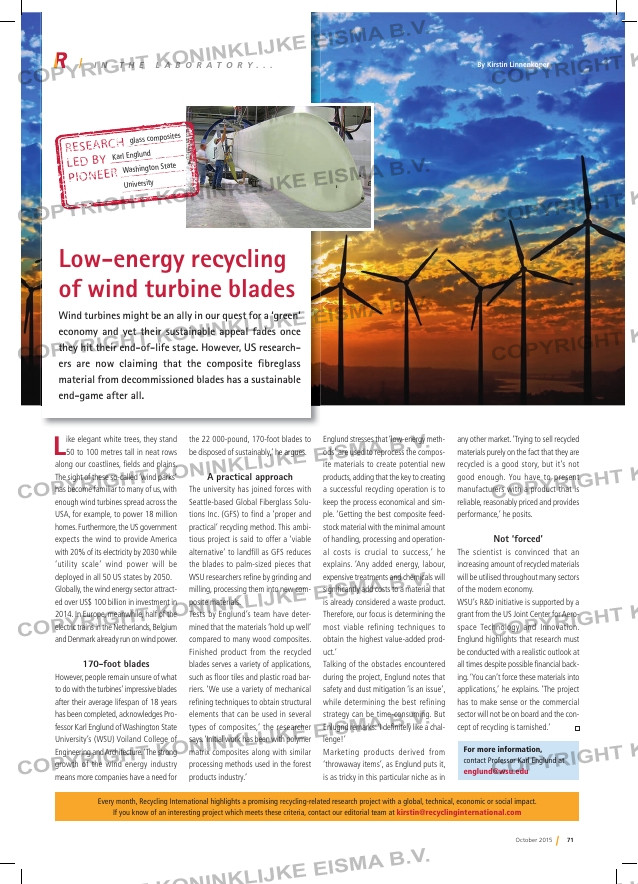Page 73 from: October 2015

71October 2015
Like elegant white trees, they stand 50 to 100 metres tall in neat rows
along our coastlines, fields and plains.
The sight of these so-called ‘wind parks’
has become familiar to many of us, with
enough wind turbines spread across the
USA, for example, to power 18 million
homes. Furthermore, the US government
expects the wind to provide America
with 20% of its electricity by 2030 while
‘utility scale’ wind power will be
deployed in all 50 US states by 2050.
Globally, the wind energy sector attract-
ed over US$ 100 billion in investment in
2014. In Europe, meanwhile, half of the
electric trains in the Netherlands, Belgium
and Denmark already run on wind power.
170-foot blades
However, people remain unsure of what
to do with the turbines’ impressive blades
after their average lifespan of 18 years
has been completed, acknowledges Pro-
fessor Karl Englund of Washington State
University’s (WSU) Voiland College of
Engineering and Architecture. ‘The strong
growth of the wind energy industry
means more companies have a need for
the 22 000-pound, 170-foot blades to
be disposed of sustainably,’ he argues.
A practical approach
The university has joined forces with
Seattle-based Global Fiberglass Solu-
tions Inc. (GFS) to find a ‘proper and
practical’ recycling method. This ambi-
tious project is said to offer a ‘viable
alternative’ to landfill as GFS reduces
the blades to palm-sized pieces that
WSU researchers refine by grinding and
milling, processing them into new com-
posite materials.
Tests by Englund’s team have deter-
mined that the materials ‘hold up well’
compared to many wood composites.
Finished product from the recycled
blades serves a variety of applications,
such as floor tiles and plastic road bar-
riers. ‘We use a variety of mechanical
refining techniques to obtain structural
elements that can be used in several
types of composites,’ the researcher
says. ‘Initial work has been with polymer
matrix composites along with similar
processing methods used in the forest
products industry.’
Englund stresses that ‘low-energy meth-
ods’ are used to reprocess the compos-
ite materials to create potential new
products, adding that the key to creating
a successful recycling operation is to
keep the process economical and sim-
ple. ‘Getting the best composite feed-
stock material with the minimal amount
of handling, processing and operation-
al costs is crucial to success,’ he
explains. ‘Any added energy, labour,
expensive treatments and chemicals will
significantly add costs to a material that
is already considered a waste product.
Therefore, our focus is determining the
most viable refining techniques to
obtain the highest value-added prod-
uct.’
Talking of the obstacles encountered
during the project, Englund notes that
safety and dust mitigation ‘is an issue’,
while determining the best refining
strategy can be time-consuming. But
Enlugnd remarks: ‘I definitely like a chal-
lenge!’
Marketing products derived from
‘throwaway items’, as Englund puts it,
is as tricky in this particular niche as in
any other market. ‘Trying to sell recycled
materials purely on the fact that they are
recycled is a good story, but it’s not
good enough. You have to present
manufacturers with a product that is
reliable, reasonably priced and provides
performance,’ he posits.
Not ‘forced’
The scientist is convinced that an
increasing amount of recycled materials
will be utilised throughout many sectors
of the modern economy.
WSU’s R&D initiative is supported by a
grant from the US Joint Center for Aero-
space Technology and Innovation.
Englund highlights that research must
be conducted with a realistic outlook at
all times despite possible financial back-
ing. ‘You can’t force these materials into
applications,’ he explains. ‘The project
has to make sense or the commercial
sector will not be on board and the con-
cept of recycling is tarnished.’
Every month, Recycling International highlights a promising recycling-related research project with a global, technical, economic or social impact.
If you know of an interesting project which meets these criteria, contact our editorial team at [email protected]
For more information,
contact Professor Karl Englund at
[email protected]
I N T H E L A B O R A T O R Y . . .
Low-energy recycling
of wind turbine blades
Wind turbines might be an ally in our quest for a ‘green’
economy and yet their sustainable appeal fades once
they hit their end-of-life stage. However, US research-
ers are now claiming that the composite fibreglass
material from decommissioned blades has a sustainable
end-game after all.
By Kirstin Linnenkoper
RESEARCH
LED BY
PIONEER
R SEARCH
LED BY
PIONEER
glass co
mposites
Karl Englund
Washingto
n State
University



